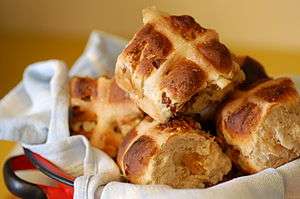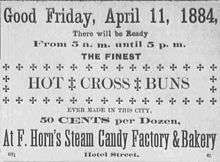Hot cross bun
A hot cross bun is a spiced sweet bun usually made with fruit, marked with a cross on the top, and traditionally eaten on Good Friday in the United Kingdom; Ireland; Australia; India; New Zealand; South Africa; and some parts of the Americas,including Canada and the United States.
 Homemade hot cross buns | |
| Type | Spiced bun |
|---|---|
| Place of origin | United Kingdom |
| Region or state | England |
| Main ingredients | Flour, currants or raisins with spices |
The bun marks the end of Lent and different parts of the hot cross bun have a certain meaning, including the cross representing the crucifixion of Jesus, and the spices inside signifying the spices used to embalm him at his burial.[1][2]
They are now available all year round in some places.[3] Hot cross buns may go on sale in the United Kingdom, Australia and New Zealand even as early as New Year's Day[4] or after Christmas.[5]
History
In many historically Christian countries, plain buns made without dairy products (forbidden in Lent until Palm Sunday) are traditionally eaten hot or toasted during Lent, beginning with the evening of Shrove Tuesday (the evening before Ash Wednesday) to midday Good Friday.
The Greeks in 6th century AD may have marked cakes with a cross.[6]
One theory is that the Hot Cross Bun originates from St Albans, in England, where Brother Thomas Rodcliffe, a 14th-century monk at St Albans Abbey, developed a similar recipe called an 'Alban Bun' and distributed the bun to the local poor on Good Friday, starting in 1361.[7]
In the time of Elizabeth I of England (1592), the London Clerk of Markets issued a decree forbidding the sale of hot cross buns and other spiced breads, except at burials, on Good Friday, or at Christmas. The punishment for transgressing the decree was forfeiture of all the forbidden product to the poor. As a result of this decree, hot cross buns at the time were primarily made in domestic kitchens. Further attempts to suppress the sale of these items took place during the reign of James I of England (1603–1625).[8]
The first definite record of hot cross buns comes from a London street cry: "Good Friday comes this month, the old woman runs. With one or two a penny hot cross buns", which appeared in Poor Robin's Almanac for 1733.[9] Food historian Ivan Day states, "The buns were made in London during the 18th century. But when you start looking for records or recipes earlier than that, you hit nothing."[3]
Traditions

English folklore includes many superstitions surrounding hot cross buns. One of them says that buns baked and served on Good Friday will not spoil or grow mouldy during the subsequent year. Another encourages keeping such a bun for medicinal purposes. A piece of it given to someone ill is said to help them recover.[10]
If taken on a sea voyage, hot cross buns are said to protect against shipwreck. If hung in the kitchen, they are said to protect against fires and ensure that all breads turn out perfectly. The hanging bun is replaced each year.[10]
Other versions
In the United Kingdom, the major supermarkets produce variations on the traditional recipe such as toffee, orange-cranberry, salted caramel and chocolate, and apple-cinnamon.[11]
In Australia, coffee-flavoured buns are also sold in some bakeries.[12] There are also sticky date and caramel versions, as well as mini versions of the traditional bun.[13] Other newer variations that can be purchased from major supermarkets include chocolate and cherry, butterscotch[14], apple & cinnamon, banana and caramel and white chocolate and raspberry.[15]
The not cross bun is a variation on the hot cross bun. It uses the same ingredients but instead of having a cross on top, it has a smiley face in reference to it being "not cross" in the sense of not angry. The not cross bun was first sold commercially in 2014 by an Australian bakery, Ferguson Plarre Bakehouses, in response to supermarkets selling hot cross buns as early as Boxing Day (26 December).[16]
In Slovakia and in the Czech Republic, mazanec is a similar cake or sweet bread eaten at Easter. It often has a cross marked on top.[17]
The cross

The traditional method for making the cross on top of the bun is to use shortcrust pastry;[18][19] however, more recently, recipes have recommended a paste consisting of flour and water.[20]
See also
| Wikibooks has a book on the topic of: Cookbook:Hot Cross Bun |
| Wikimedia Commons has media related to Hot cross buns. |
- Bath bun
- Fruit bun
- Sally Lunn bun
- List of British breads
- List of buns
- List of foods with religious symbolism
- Semla Scandinavian and German festive Lenten bun
References
- Turner, Ina; Taylor, Ina (1999). Christianity. Nelson Thornes. p. 50. ISBN 9780748740871.
To mark the end of the Lent fast Christians eat hot cross buns. These have a special meaning. The cross in the middle shows how Jesus died. Spices inside remind Christians of the spices put on the body of Jesus. Sweet fruits in the bun show that Christians no longer have to eat plain foods.
- Fakes, Dennis R. (1 January 1994). Exploring Our Lutheran Liturgy. CSS Publishing. p. 33. ISBN 9781556735967.
Since people often gave up meat during Lent, bread became one of the staples of Lent. Bakers even began making dough pretzels--a knotted length of dough that represented a Christian praying, with arms crossed and hands placed on opposite shoulders. Hot cross buns are popular during Lent. The cross of course reminds the eater of Christ's cross.
- Rohrer, Finlo (1 April 2010). "BBC - How did hot cross buns become two a penny?". BBC News. Retrieved 26 April 2014.
- "Hot Cross Buns on sale already". au.tv.yahoo.com. 4 January 2012. Archived from the original on 16 October 2014. Retrieved 28 December 2013.
- Dodd, Kate (3 January 2014). "Easter's come early: hot cross buns already on shelves". The Toowoomba Chronicle. Retrieved 30 April 2014.
- "Who Were The First To Cry "Hot Cross Buns?"". The New York Times. 31 March 1912. Retrieved 4 May 2010.
- "The City of St Albans Claims the Original Hot Cross Bun". St Albans Cathedral. Archived from the original on 16 March 2018. Retrieved 7 December 2016.
- David, Elizabeth (1980). "Yeast Buns and Small Tea Cakes". English Bread and Yeast Cookery. New York: The Viking Press. pp. 473–474. ISBN 0670296538.
- Charles Hindley (2011). "A History of the Cries of London: Ancient and Modern". p. 218. Cambridge University Press,
- "Hot Cross Buns". Practically Edible: The Web's Biggest Food Encyclopedia. Practically Edible. Archived from the original on 3 April 2009. Retrieved 9 March 2009.
- "The best hot cross buns 2019". BBC Good Food. Retrieved 1 July 2019.
- "Easter Baking: Hot Cross Buns". jeanniebayb.livejournal.com. 24 March 2008. Archived from the original on 5 April 2010. Retrieved 26 March 2008.
- "Yummy Hot Cross Buns". Woolworths (Australia). Retrieved 30 April 2014.
- https://shop.coles.com.au/everything/search/hot%20cross%20buns
- https://www.woolworths.com.au/shop/search/products?searchTerm=hot%20cross%20buns
- "Baker launches war on supermarkets' early hot cross bun sales". Good Food. Retrieved 15 March 2016.
- "Easter in Czech Republic". iloveindia.com. Retrieved 7 December 2007.
- Berry, Mary (1996). Mary Berry's Complete Cookbook (First edition (2nd reprint) ed.). Godalming, Surrey: Dorling Kindersley. p. 386. ISBN 1858335671.
- Smith, Delia (1986). Delia Smith's Cookery Course (First edition (8th reprint) ed.). London: British Broadcasting Corporation. p. 62. ISBN 0563162619.
- "The Great British Bake-off: Paul Holywood's Hot Cross Bun", Easy Cook (magazine) (60), p. 38, April 2013